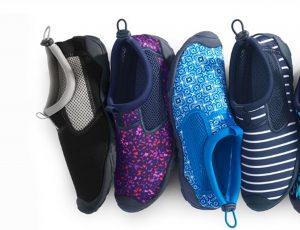One of the most important things to keep in mind when going to a beach is about the footwear. In some cases, it might be important to avoid wearing certain items, like fancy water shoes.
So, I want to talk about the possible implications of swimming in water shoes. Can you swim in water shoes?
The short answer is, it depends. If you’re swimming in a pool or a body of water that is relatively shallow, then you can most likely swim in water shoes. However, if you’re swimming in a river or ocean full of deep and cold water, then it might not be a good idea to wear them. Let use know more reasons.
Can you swim in water shoes?
Water shoes are not designed to protect your feet from contact with water, Recently I faced a question online whether can you wear water shoes at Volcano bay? In fact, they may even be dangerous if you’re trying to swim in some places.
1. While water shoes are not designed to protect your feet from contact with water, they are not dangerous to swim in if you’re careful. However, be aware that they may not provide the protection you need if you’re swimming in cold or turbulent water.

2. When entering the water and when exiting it, be cautious to avoid strong currents and stay close to shore until conditions have calmed down.
3. Check the temperature before swimming; if it’s too hot or too cold, don’t go in the water with normal water shoes!
4. Keep both hands free for balance and steering while wearing these shoes; don’t try to hold onto anything while wearing them.

5 things to keep in mind
5 things that you should keep in mind always while going to the beach while river shoes on:
1. Use water shoes which are properly fitted.
Water shoes should be snug but not tight. You should be able to wiggle your toes, but they shouldn’t come off. Over the time, water shoes may run big, check that before using.

If you’re planning on swimming in your beach shoes, make sure they’re properly fitted. Water shoes should be snug but not tight. You should be able to wiggle your toes, but they shouldn’t come off. They also need to be water reistant so you can stay safe while swimming in the pool or ocean.

If it’s too hot or too cold, don’t go in the water! If you’re swimming near a body of water with a different temperature, it’s important to check the temperature before jumping in. Make sure to bring along sunscreen and rain gear if it’s sunny out and you’re swimming in the water.
If you’re wearing river shoes, be careful not to lose your balance while trying to swim. Keep both hands free by holding onto something stable like a rope or dock. Steering can be tricky when you have wet hands, so avoid getting into dangerous situations by keeping your head up and looking around.
And lastly, remember that all water shoes are not meant for diving or snorkeling – keep that in mind when planning your day at the beach!
2. Always use comfortable water shoes.
They should conform to your feet and provide cushioning. Water shoes are designed to keep your feet dry, but they can be uncomfortable if they don’t fit well. The fit is important because it should conform to your feet and provide cushioning. If the water shoe is too small, it can cause blisters and even injury. If the water shoe is too big, it will get wet and cold inside, making it difficult to move in the water.

3. Water resistant water shoes are preferred.
If you’re going to be swimming or kayaking, make sure they’re water resistant. Water shoes are designed to be worn in water, but they’re not always water resistant. If you’re going to be swimming in them, make sure they’re at least water resistant. Water Shoes should also have a drainage system so that water can escape if it gets inside the shoe.
4. Make sure your water shoes are safe.
Water shoes are not designed to protect your feet from contact with water. In fact, they may even be dangerous if you’re trying to swim. If you’re planning on swimming in water shoes, it is important to make sure that they are safe.

While some water shoes have a rubber soles that help you stay on the ground when in the water, other models do not and may actually float. If you’re unsure whether or not your water shoe is safe for swimming, always consult with a safety expert before taking any risks.

5. Make sure water shoes are appropriate for the activity you’re going to be doing.
If you’re going to be kayaking, make sure your water shoes are appropriate best kayaking shoes.

See a reel on best shoes for kayaking:
If you’re looking to get in some aquatic fun this summer, make sure your water shoes are safe for swimming and other activities.
Water shoes for swimming: Final Talk
It’s important to know that most water shoes aren’t suitable for swimming. In fact, the majority of them are made out of rubber or plastic and won’t hold up well when submerged in water. If you’re looking to swim in them, make sure they’re specifically made for swimming or kayaking. You should concern more while choosing best water shoes for kids than men’s and women’s water shoes.
When you’re going to be using your water shoes for anything like swimming other than aquatic activities (like walking on the beach), be sure to put them back on once you’re done. Wet feet = a lot of discomfort for both men’s and women’s water shoe swimming users!
